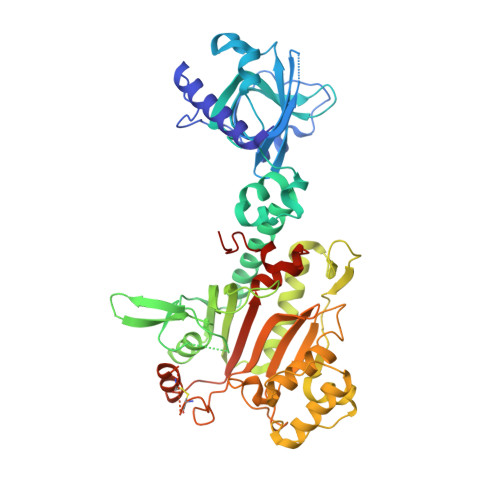Inhibition of Plasmodium falciparum Lysyl-tRNA synthetase via an anaplastic lymphoma kinase inhibitor.
Zhou, J., Huang, Z., Zheng, L., Hei, Z., Wang, Z., Yu, B., Jiang, L., Wang, J., Fang, P.(2020) Nucleic Acids Res 48: 11566-11576
- PubMed: 33053158
- DOI: https://doi.org/10.1093/nar/gkaa862
- Primary Citation of Related Structures:
7BT5 - PubMed Abstract:
Aminoacyl-tRNA synthetases are attractive targets for the development of antibacterial, antifungal, antiparasitic agents and for the treatment of other human diseases. Lysyl-tRNA synthetase (LysRS) from this family has been validated as a promising target for the development of antimalarial drugs. Here, we developed a high-throughput compatible assay and screened 1215 bioactive compounds to identify Plasmodium falciparum cytoplasmic LysRS (PfLysRS) inhibitor. ASP3026, an anaplastic lymphoma kinase inhibitor that was used in clinical trials for the treatment of B-cell lymphoma and solid tumors, was identified as a novel PfLysRS inhibitor. ASP3026 suppresses the enzymatic activity of PfLysRS at nanomolar potency, which is >380-fold more effective than inhibition of the human counterpart. In addition, the compound suppressed blood-stage P. falciparum growth. To understand the molecular mechanism of inhibition by ASP3026, we further solved the cocrystal structure of PfLysRS-ASP3026 at a resolution of 2.49 Å, providing clues for further optimization of the compound. Finally, primary structure-activity relationship analyses indicated that the inhibition of PfLysRS by ASP3026 is highly structure specific. This work not only provides a new chemical scaffold with good druggability for antimalarial development but also highlights the potential for repurposing kinase-inhibiting drugs to tRNA synthetase inhibitors to treat human diseases.
- State Key Laboratory of Bioorganic and Natural Products Chemistry, Center for Excellence in Molecular Synthesis, Shanghai Institute of Organic Chemistry, University of Chinese Academy of Sciences, Chinese Academy of Sciences, 345 Lingling Road, Shanghai 200032, China.
Organizational Affiliation:


















